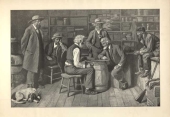The Checker Maven
The World's Most Widely Read Checkers and Draughts Publication
Bob Newell, Editor-in-Chief
Published every Saturday morning in Honolulu, Hawai`i
Noticing missing images? An explanation is here.
Fifth Reprise: Two Easy Pieces
Here is the fifth installment of our continuing series from Willie Ryan's classic Tricks Traps & Shots of the Checkerboard. As always, we're here to listen to the man himself; click on Read More to check your solutions.
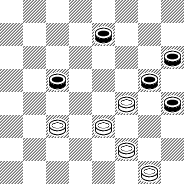
White to Play and Win
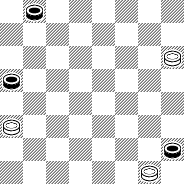
White to Play and Win
A Great Shot, But Can You Win The Ending?

Pexels CC0
(We are taking a short break and so this really is our last Wednesday column until September. Saturday columns will of course continue without interruption.)
On this "Anything Can Happen" Wednesday, we bring you a game played by guest author Ingo Zachos in a recent matchup on the It's Your Turn on-line game site. Capitalizing on an error by his opponent, Ingo finds a thrilling shot--- and then still has to demonstrate the win in the endgame! We've interspersed Ingo's own interesting comments and analysis with our own, which are due to running the world-class King's Row program at 15 minutes per move.
Ingo Zachos - Raymond Faircloth
It's Your Turn January 2005
with commentary by Ingo Zachos
1.11-15 23-18
2.8-11 27-23
3.4-8 23-19
4.10-14 19x10
5.14x23 26x19
6.6x15
I know 6.7x14 is the fashion, but I was inspired by Game 7 of the GAYP World Championship of 1956, Wiswell- Fraser, after reading International Checkers and Draughts.
6...19x10
7.7x14 24-19
8.11-16 31-26
Here Fraser played 8...19-15 and after 9.16-19 22-17 10.14-18 25-22 11.18x25 29x22 12.12-16 22-18 13.16-20 17-14 14.9-13 14-10 15.19-23 18-14 16.2-7 31-26 17.7-11 26x19 18.11x18 he played 19-16 and lost, thus: (18...32-27 19.18-22 19-16 20.8-12 16-11 21.12-16 28-24 22.22-25 21-17 23.13x22 30x21 24.22-26 21-17 25.26-31 10-7 26.3x10 14x7 27.1-6 7-3 28.6-10 3-7 29.10-15 7-10 30.16-19 27-23 31.19x26 10x19 32.20x27 19-23 is given by Dr. Fraser as drawn.) 19.18-23 16-12 20.8-11 10-7 21.3x17 21x14 22.1-6 12-8 23.13-17 8-3 24.17-21 3-8 25.23-27 8x15 26.6-9 32x23 27.9x27 28-24 28.27-31 24-19 29.20-24 15-18 30.24-28 19-16 31.28-32 18-22 32.32-27 16-12 33.5-9 22-17 34.27-23 12-8 35.23-19 8-3 36.19-15 3-7 37.31-27 7-2 38.15-10 17-22 39.27-23
9.16x23 26x19
10.8-11!?
10.9-13 trying to avoid the rapid advance of White's single corner side, is better, but I underestimated the power of the man on 15. (King's Row thinks any of 2-6, 1-6, 2-7, 8-11, 9-13, or 3-7 are about equal. --Ed.)
10...19-15
11.11x18 22x15
12.12-16
I also calculated 12.2-7 28-24! but there seemed to be equality with less chances of a tactical surprise. (The idea was the trick 12...15-10? 13.14-17 21x14 14.9x18 to a neat win.) 12.3-8?! would be a minor variation because of 15-10 and the piece on 10 is very disturbing. (In fact, Kings's Row agrees that 3-8 is weak. --Ed.)
12...15-11?!
13.14-17!?
Sometimes masters say they calculate 50 moves ahead. Well, here I already saw the final position of this game in my mind very clearly and knew it was won.
13.1-6 as indicated by the programs, might be better, but during the game I evaluated it as drawn.
(Editor's note: King's Row thinks 12. ... 15-11 is inferior, though not an outright loss, and prefers 30-26 or 25-22. But King's Row disagrees with our author over 13.14-17, rating the resulting position as a draw. As our author points out 1-6 is preferred but the game is still far from a win.)
13...21x14
14.9x18 30-26?
Believe it or not, this is already the fatal mistake.
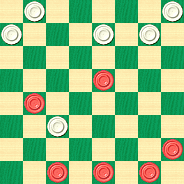
RED
Red to Play and Win
(Editor's note: let's pause here. Ingo is about to play an exciting shot. Can you spot it? And if you can, are you able to demonstrate the win after the shot is complete? When you've figured it out, click on Read More to see the rest of the game.)
[Read More]The Last of the Masked Men
Our Masked Man problem series draws to a close with this month's article. We hope you've enjoyed it. Perhaps we can run another similar series sometime in the future.
If you can identify the problemist in the photo below, you're doing really well at this sort of thing.

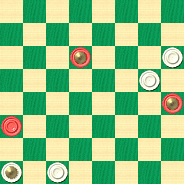
WHITE
White to Play and Win
Can It Be Done?
Check your solution by clicking on Read More. Intended to be of "medium" difficulty, this one packs a surprise. Even if you solve it easily, though, by all means read the commentary which accompanies the solution.
[Read More]Three Easy Strokes, Part Two
We continue again this month with our "summer light" series of easier-than-usual stroke problems with this offering for June, which is, as you will see if you figure it out, a bit mis-labeled. And be forewarned, after this series concludes it's back to the hard ones!
After you solve it click on Read More to check your answer.
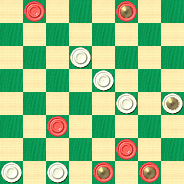
WHITE
White to Play and Win
It's Not Just About Winning: A Checker Maven Editorial

PxHere CC0
Controversy rages today, as it did nearly 80 years ago, over the selection of the US team in the upcoming 100th Anniversary US-Great Britain match, to be held in Las Vegas in September. One look at the postings on the Checker Solutions BBS tells the story... and that story has many angles and viewpoints.
In brief, the controversy is over the exclusion of venerable grandmaster Leo Levitt from the US team. As near as we can determine from the BBS postings, Mr. Levitt was originally asked to play, but a vote by a team selection group determined that Mr. Levitt should sit out in favor of a possibly younger, more recently active player.
This type of discussion is nothing new. Let's turn back to a publication we've quoted before, The Morris-Systems Checkerist for September-October 1926. At that time in checker history, the US team was being chosen for the 2nd International Match between the US and Great Britain.
The lead story in the Checkerist was titled "International Team Will Select 11th and 12th Men at Once" and bore the telling subtitle "Matches Called Off Due to Lack of Harmony Amongst Players." An article titled "An Old Timer Comments" by John H. Finn of the Lynn Item stated:
"Yes, the hand of time bears heavily upon all of us and none can escape its fierce grip. The American players are growing old, too, and sooner or later all of the great ones will be too old to get a grip on the game and hold that grip for many moves ... it cannot be said that an old man is one who would be preferred for team play. This applies generally to all who have reached that stage in life when they prefer rest rather than excitement...."
With all due respect, Mr. Finn, we think you were somewhere out in left field with your comments, and as the saying goes, you confused "retired" with "tired." And you tragically underestimated the immeasurable value of the older generation.
The Checker Maven editorial staff cannot support Mr. Finn's 1926 position vis-a-vis the 2nd International Match and likewise cannot support the 2005 decision to omit Mr. Levitt from the US team being assembled for the 100th Anniversary Match.
We base this position not on our knowledge of checkers, which our readers know is limited at best, nor on our familiarity with the players and their abilities, which is likewise circumscribed. Nor do we intend our position to be a criticism of the American Checker Federation or the team selection officials, who we believe to be acting according to what they see as their mandate. They are in an unfortunate no-win situation and will face criticism regardless of their final decision.
We base our position instead on what we learned from our father, of blessed memory, who taught us checkers many decades ago.
We learned that there are things more important than winning. While we learned to play to win, we learned to lose with sportsmanship and grace. We learned that checkers is all about honor, respect, perseverance, humility, hard work, ethics, and ultimately, wisdom. Over time, we've come to see these attributes in the checker community at large and it's cemented our relationship to the Game of Kings.
In the light of these precious principles, which make checkers much more than just a game, and all about much more than just winning, we ask if the exclusion of Mr. Levitt from the US team upholds and serves these principles; and we fear that it in fact does not. We ask whether disappointing an aging grandmaster who has contributed immeasurably to our game, and likely has much more still to offer, is in our best interests. (Mr. Levitt's record of 32 wins with only 1 loss and 45 draws in previous International matches speaks for itself.)
Likewise, we admire and applaud the offer of a young and highly skilled player, Clayton Nash, to stand aside to make room for Mr. Levitt. In making this offer, Mr. Nash models behavior and attributes that are a worthy example for us all, and acts in the true spirit of our game.
We do not know how this will all turn out in the end. But we will close with this question: if, in pursuing the goal of victory, we sacrifice our principles, what do we really win?![]()
Did Marvin Blow The Game?

The Detroit Doublejumpers, lead by their intrepid team captain, Marvin J. Mavin, were at the St. Louis Sports Drome for a contest with the St. Louis Switchers. Marvin was engaged in a First Board match with the Switchers captain, that intrepid French National named Jean Luc Louis Claude Simon Tournevise, otherwise known as "Louie Screwdriver."
"You 'ave made a vehree bad ligne of play," remarked Louie with a curling of the lip and a bit of a sneer. "Maintenant, I will 'ave to show you zee ehror of zis ligne by giving you zee beating!"
Here is how the game had played out so far. Marvin, who was commanding the Red pieces, and Louie, in charge of the White forces, had indulged themselves in this line of the Single Corner:
| 1. | 11-15 | 22-18 |
| 2. | 15x22 | 25x18 |
| 3. | 12-16 | 29-25 |
| 4. | 10-14 | 24-19 |
| 5. | 16-20 | 25-22 |
| 6. | 7-10 | 28-24 |
| 7. | 8-12 | 32-28 |
| 8. | 4-8 | 30-25 |
| 9. | 3-7 | 18-15 |
| 10. | 9-13 | 19-16 |
| 11. | 12x19 | 23x16 |
| 12. | 10x19 | 24x15 |
| 13. | 8-12 | 15-11 |
| 14. | 12x19 | 11-8 |
| 15. | 7-10 | 8-3 |
| 16. | 2-7 | ... |
This resulted in the following position, with White to play:
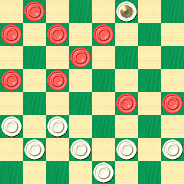
WHITE (Louie)
White to Play - Can White Win?
Marvin seemed only slight irritated by Louie's taunts. He simply replied, in his most politically incorrect manner, "Well there, Monsieur Frenchy, you ain't a gonna pull this one off nohow!" Louie looked puzzled. "Ah, I do not un-derstand zis American way of fun-ee talk-ing," he replied, "but I un-derstand 'ow to make of zis game a vic-toree!"
What do you think? Try your luck and skill on these questions:
1. Can White (Louie) find a win in this position? What might it be?
2. Does Red have something up his sleeve, or did Marvin perhaps have a little too much pre-game beer?
3. What do you think of this line of the Single Corner? Did Red play well? Did White?
Watch The Checker Maven for the conclusion of this story, and the answers to all these questions and much more, in a few weeks' time.
French-English Glossary
ligne line, as in "line of play."
maintenant now, as in "now I'll show you!"
tournevis screwdriver.
Note: In this article, we're trying out a different diagram style and using the term "Red" instead of "Black" --- all in response to reader feedback. Let us know what you think.![]()
It's Easy When You Know How
A recent addition to the library in our Santa Fe office is an item we've sought for quite some while: W.T. Call's Midget Problems, published in 1913. We think the following quotation from the preface to this little booklet is revealing:
'Are not these little problems easy?
'Yes, when you are looking at the solutions.'
Over the coming months we'll be featuring some selections from this work, which features nothing but problems with two pieces per side, hence the title, Midget Problems. But as the preface warns, these are small only in size, not in challenge.
We'd like to start out with an offering that you might consider trite; and frankly, we'd have to agree, yet there is a method to our madness. It is a setting of First Position, credited to Dr. T. J. Brown of Limerick, who put this forth around the year 1870.

BLACK
Black to Play and Win
And when you've worked through this setting (you can click here for an animation of Dr. Brown's trunk solution), answer this trivia question, also credited to Dr. T. J. Brown. What is the earliest published example of First Position? Can you name the author and year? If you can, you really know your draughts history.
But before you're done, tell us, if you can, what White's last move might have been, and then draw a conclusion from your answer. (Thanks go to Brian Hinkle for this one.)
As usual, click on Read More for the answers.
[Read More]A Tommie Wiswell Saturday Bonus!
As a special Saturday extra for our readers, we offer this Tommie Wiswell Prize Problem, which is actually somewhat easier than most Wiswell offerings, but certainly no less elegant.
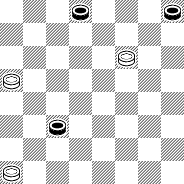
WHITE
White to Play and Draw
Rush Hour

Public Domain Pictures CC0
Let's stay out of the traffic and have a "rush hour" of a different sort. Can you rush to solve this month's speed problems? Click on the links to show the problem, and start the clock. Go as fast as you can; the train's leaving the station!
Click on Read More to check your solutions.
(We are always in need of speed problems. If you have any that you'd like us to publish, please contact us using the contact link in the left column. We are looking for problems that are much harder than the ones we've been publishing but still easy enough for an experienced player to solve in under five minutes.)
Problem No. 1. Very easy.
Problem No. 2. Easy.
![]()
Results of the Checker Maven Reader's Survey
Reminder: we have switched to our summer publication schedule, which means we don't always publish a Wednesday edition.

Openclipart CC0
Our thanks to everyone who participated in our recent Checker Maven reader's survey. We received a wonderful response, filled with constructive criticism and excellent suggestions. Overall, you seem to like The Checker Maven!
By far the most asked-for feature was current checker news and annotated games from recent tournaments and matches. This may actually turn out to be the most difficult request to deliver upon, as tournament and match games generally have specific ownership and publication rights and limitations. But we're going to try to recruit a network of volunteer "stringers" and we'll make every effort to provide this type of content in the future. Bear with us; it may take some time to put this together.
Problems proved quite popular; you were about evenly split on whether they were too hard, too easy, or about right. This tells us that our mix is good; but we agree that the speed problems are usually too simple.
Book and computer program reviews have their audience as well, although these appeal to a more focused group. Still, the response certainly indicates that we should continue with this type of material.
The most controversy seemed to be over the Marvin J. Mavin stories. Most folks thought they were OK or better; a few people really loved them; and others--- well, let's just say that they and Marvin have a bit of a personality clash. The bottom line for us: we'll continue to run these stories but we won't focus on them or publish them more than every month or two.
The "Masked Man" features garnered one negative mention as well; we didn't get a reason but it might be that the quality of the problems in those articles tended to be lower than in the other problem features. We'll run the one or two more that are already in the publication queue, and that will probably be the end of the line unless we can upgrade the caliber.
Various and varied suggestions included requests for: easier to read diagrams, a return to the click-and-type system of commenting on articles, better indexing, and RSS syndication, among others. We plan to work on all of these over the next weeks as time allows.
Publication frequency of once or twice a week seemed about right to most of you, although there were a couple of requests for daily publication! Alas, that just can't be in the cards for the forseeable future.
As we publish this summary, we're completing a half year of regular, on-time, uninterrupted Checker Maven publication. Our thanks to our nearly 1,000 regular readers for making this webzine a success far beyond anything we ever had a right to expect. We'll do our best to continue to please and to be responsive to your suggestions and input.![]()
The Checker Maven is produced at editorial offices in Honolulu, Hawai`i, as a completely non-commercial public service from which no income is obtained or sought. Original material is Copyright © 2004-2025 Avi Gobbler Publishing. Other material is public domain, AI generated, as attributed, or licensed under CC1, CC2,CC3 or CC4. Information presented on this site is offered as-is, at no cost, and bears no express or implied warranty as to accuracy or usability. You agree that you use such information entirely at your own risk. No liabilities of any kind under any legal theory whatsoever are accepted. The Checker Maven is dedicated to the memory of Mr. Bob Newell, Sr.


